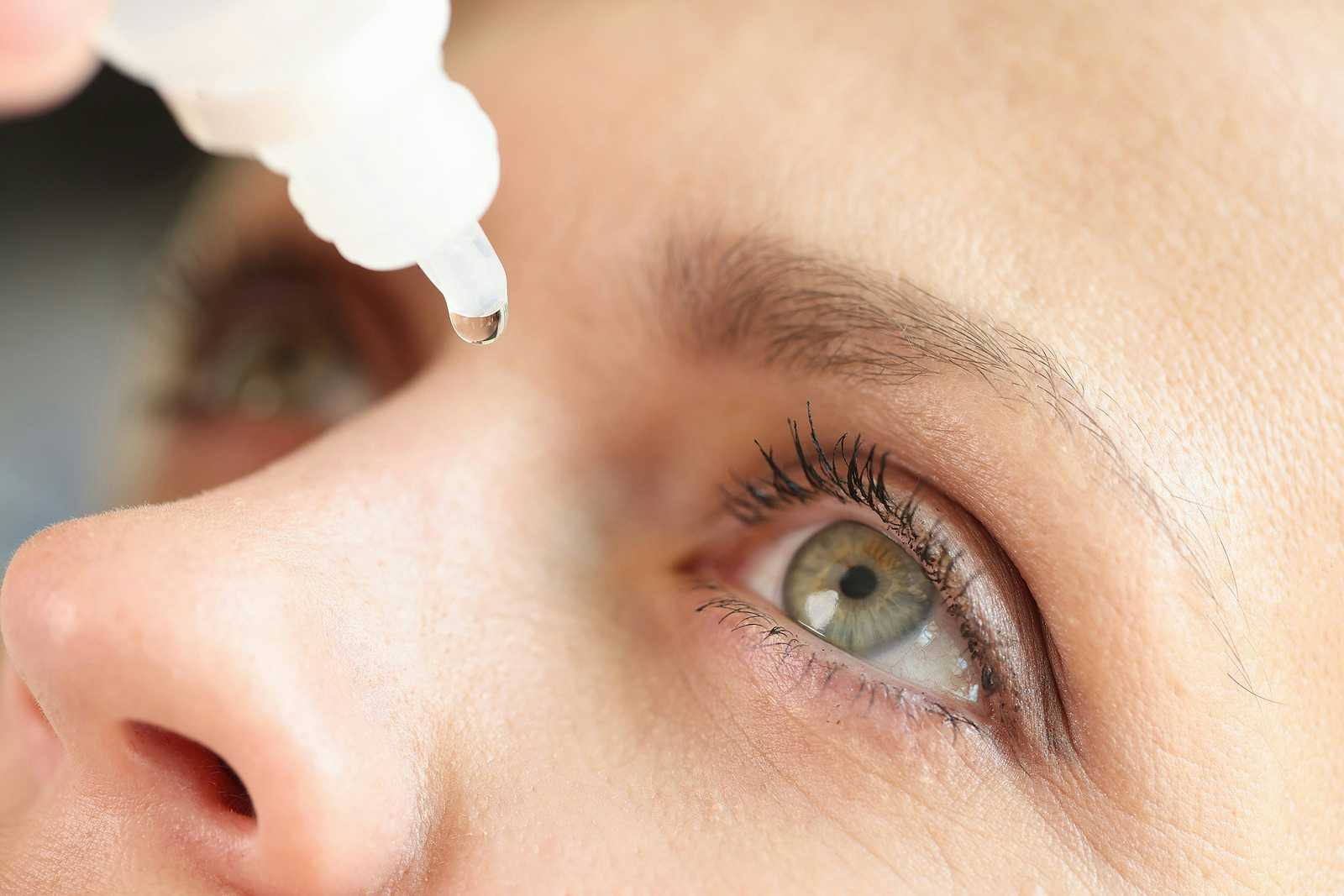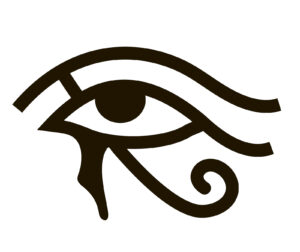
Here we go again! Last summer dozens of Americans developed eye infections that were traced to contaminated eye drops. Some people suffered permanent loss of vision because of the infections. The FDA is now cautioning consumers to avoid many lubricant eye drops because of concerns about contamination. This is bad news for tens of millions of people who rely on such eye drops to overcome disabling dry eye symptoms. Are you concerned about the FDA’s eye drop warning?
Did Our Ancestors Need Eye Drops?
Have humans always suffered from dry eyes? Is this a natural condition of aging? I could find no reference to the frequency of dry eyes in our distant ancestors. Did Neanderthals have to deal with DED (dry eye disease)? What about the ancient Greeks and Egyptians?

There is reference to dark “eye paste” going back over 4,000 years. You have no doubt seen the ancient Egyptian symbol of the Eye of Horus with black paste around eyelid margins. The theory is that this eye make-up reduced the glare of the sun. It may have had some anti-infective properties, but there are no data to suggest that ancient Egyptians used drops to protect against DED.
What Causes Modern Dry Eyes?
Researchers didn’t start studying dry eyes scientifically until late in the 20th century. Dr. Frank Holly described the “Formation and Rupture of the Tear Film” in the journal Experimental Eye Research, May 10, 1973.
We now know that there are many causes of dry eye disease. Anticholinergic drugs are one contributor. You can find a list of such medications at this link. Very few health professionals stop to think about drug-induced dry eye disease, but it should be considered before someone starts down the road of pricey dry eye treatments.
Other contributors to DED can be autoimmune diseases such as Sjögren syndrome, rheumatoid arthritis, lupus or Graves’ disease. Contact lenses and Lasik surgery may also trigger dry eye disease. Staring at a computer screen without blinking can also add to the problem.
Eye Drop Warning for DED:
The usual treatment strategy for people dealing with dry eye disease is regular use of lubricating eye drops. There are dozens of products on the market to soothe dry eyes. How well does the FDA monitor the manufacture of such products? Apparently not well enough!
Eye drops should be sterile. According to the FDA (10-30-2023):
“These products are intended to be sterile. Ophthalmic drug products pose a potential heightened risk of harm to users because drugs applied to the eyes bypass some of the body’s natural defenses.”
Eye Drop Recall Last Winter:
According to the New York Times (Feb. 2, 2023):
“The manufacturer of a brand of over-the-counter eye drops said that it was recalling the product, EzriCare Artificial Tears, after it was linked to a drug-resistant bacteria strain that has caused at least one person’s death and vision loss in five others.”
The bacteria that caused this disaster was Pseudomonas aeruginosa. According to the CDC, 55 patients in 12 states were found to be infected with drug-resistant P. aeruginosa. The number of people infected with this bacteria climbed to 68 and 16 states were involved.
The Atlanta Journal-Constitution (May 23, 2023) reported that:
“There have now been four fatalities from the bacteria Pseudomonas aeruginosa, all linked to contaminated artificial tears that have since been recalled.”
“The CDC and FDA recommend everyone stop using and throw out EzriCare Artificial Tears and two other products made by parent company Global Pharma: Delsam Pharma’s Artificial Tears and Delsam Pharma’s Artificial Ointment.
“As of May 15, the CDC has identified 81 patients in 18 states — California, Colorado, Connecticut, Delaware, Florida, Illinois, North Carolina, New Jersey, New Mexico, Nevada, New York, Ohio, Pennsylvania, South Dakota, Texas, Utah, Washington and Wisconsin — with VIM-GES-CRPA.”
It is our understanding that the products were imported from India. How did the FDA let this happen?
A New Eye Drop Warning:
On November 2, 2023 CBS News reported that there are now 27 products that might cause eye infection:
“Federal regulators are warning consumers to stop using a number of over-the-counter eye drops that may pose an infection risk, marking the latest of several alerts this year.
“The notice applies to 27 eye drop products marketed under several store brands, such as CVS Health, Rite Aid, Target Up & Up and Walmart Equate, in addition to the Leader, Rugby and Velocity Pharma brands, the Food and Drug Administration said Friday. The eye drops may contain bacteria that could cause eye infections, potentially causing vision loss or even blindness, the agency said.
“The FDA said it has not received any reports of infections from consumers who have used the suspect products. However, the agency is recommending that manufacturers pull all potentially contaminated products from store shelves.”
The FDA’s Eye Drop Warning:
The Food and Drug Administration updated its recent warning about artificial tears and eye drop products on October 30, 2023.
Here is a list from the FDA:
Eye Drop Retailers and Product Information
Retailer/ Label | Product | Product Information |
|---|---|---|
| CVS Health | Lubricant Eye Drops 15 ml (single pack) | Carboxymethylcellulose Sodium Eye Drops 0.5% w/v |
| Lubricant Eye Drops 15 ml (twin pack) | Carboxymethylcellulose Sodium Eye Drops 0.5% w/v | |
| Lubricant Gel Drops 15 ml (single pack) | Carboxymethylcellulose Sodium Eye Drops 1% w/v | |
| Lubricant Gel Drops 15 ml (twin pack) | Carboxymethylcellulose Sodium Eye Drops 1% w/v | |
| Multi-Action Relief Drops 15 ml | Polyvinyl Alcohol 0.5% w/v & Povidone 0.6% w/v & Tetrahydrozoline Hydrochloride 0.05% Eye Drops | |
| Lubricating Gel drops 10 ml | Polyethylene Glycol 400 0.4% & Propylene Glycol 0.3% Eye Drops | |
| Lubricant Eye Drops 10 ml (single pack) | Propylene Glycol Eye Drops 0.6% w/v | |
| Lubricant Eye Drops 10 ml (twin pack) | Propylene Glycol Eye Drops 0.6% w/v | |
| Mild Moderate Lubricating Eye Drops 15 ml (single pack) | Polyethylene Glycol 400 Eye Drop ‘0.25% w/v | |
| Rugby (Cardinal Health) | Lubricating Tears Eye Drops 15 ml | Hypromellose 2910-0.3% w/v & Dextran 70- 0.1% Eye Drops |
| Polyvinyl Alcohol 1.4% Lubricating Eye Drops 15 ml | Polyvinyl Alcohol Eye Drops 1.4% w/v | |
| Leader (Cardinal Health) | Dry Eye Relief 10 ml | Polyethylene Glycol 400 0.4% & Propylene Glycol 0.3% Eye Drops |
| Lubricant Eye Drops 15 ml (single pack) | Carboxymethylcellulose Sodium Eye Drops 0.5% w/v | |
| Lubricant Eye Drops 15 ml (twin pack) | Carboxymethylcellulose Sodium Eye Drops 0.5% w/v | |
| Dry Eye Relief 15 ml | Carboxymethylcellulose Sodium Eye Drops 1% w/v | |
| Eye Irritation Relief 15 ml | Polyvinyl Alcohol 0.5% w/v & Povidone 0.6% w/v & Tetrahydrozoline Hydrochloride 0.05% Eye Drops | |
| Rite Aid | Lubricant Eye Drops 15 ml (twin pack) | Carboxymethylcellulose Sodium Eye Drops 0.5% w/v |
| Lubricant Eye Drops 10 ml (twin pack) | Propylene Glycol Eye Drops 0.6% w/v | |
| Gentle Lubricant Gel Eye Drops 15 ml | Hypromellose 0.3%, Glycerin 0.2%, Dextran 70 0.1% Eye Drops | |
| Lubricant Gel Drops 15 ml | Carboxymethylcellulose Sodium Eye Drops 1% w/v | |
| Lubricating Gel Drops 10 ml | Polyethylene Glycol 400 0.4% & Propylene Glycol 0.3% Eye Drops | |
| Multi-Action Relief Drops 15 ml | Polyvinyl Alcohol 0.5% w/v & Povidone 0.6% w/v & Tetrahydrozoline Hydrochloride 0.05% Eye Drops | |
| Target | Up&Up Dry Eye Relief Lubricant Eye Drops 30 ml | Polyethylene Glycol 400 0.4% & Propylene Glycol 0.3% Eye Drops |
| Up&Up Extreme Relief Dry Eye 15 ml (single pack) | Polyethylene Glycol 400 0.4% & Propylene Glycol 0.3% Eye Drops | |
| Up&Up Extreme Relief Dry Eye 30 ml (twin pack) | Carboxymethylcellulose Sodium Eye Drops 0.5% w/v | |
| Velocity Pharma LLC | Lubricant Eye Drop 10 ml (triple pack) | Propylene Glycol Eye Drops 0.6% w/v |
| Walmart | Equate Hydration PF Lubricant Eye Drop 10 ml | Polyethylene Glycol 400 0.4% & Propylene Glycol 0.3% Eye Drops |
Questions for the FDA from The People’s Pharmacy:
We have some questions for the FDA about its eye drop warning:
- What company or companies manufactured these products?
- Where are the original manufacturers located?
- When was the last time the FDA inspected these manufacturing facilities?
- How did the FDA miss the problem for so long?
- What is the FDA doing to prevent eye drop contamination going forward?

